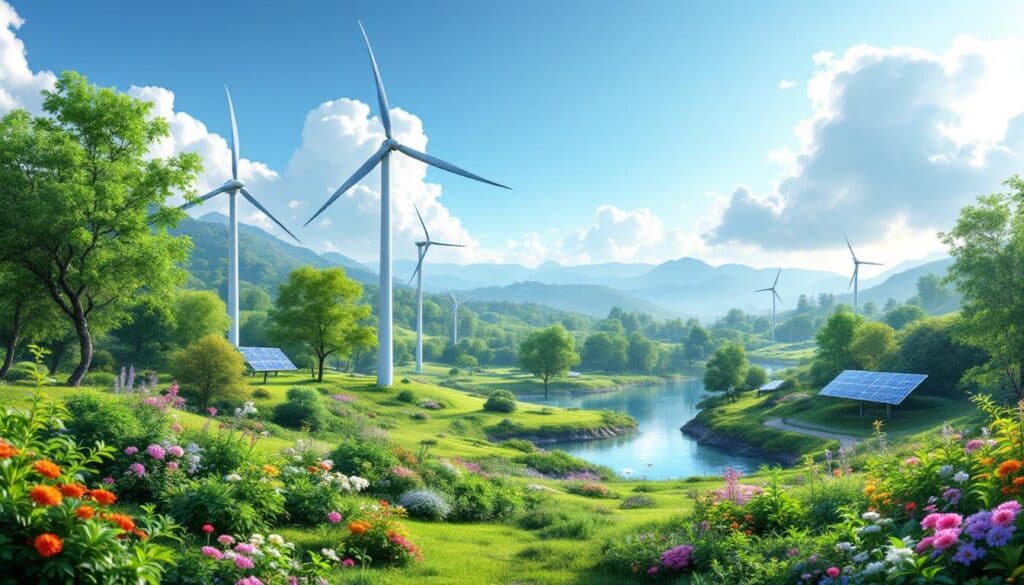Hello, my name is Sophie, and I am passionate about bioenergies and waste management.
The transition to renewable energy in the United States faces significant challenges.Despite political uncertainties, powerful forces continue to drive this change.
The American energy landscape is undergoing a major transformation. Renewable energy sources continue to gain ground, offering cleaner and more sustainable alternatives to fossil fuels. Recent reports, such as the Annual Energy Outlook 2025 and the Bloomberg NEF New Energy Outlook 2025, highlight a steady increase in green electricity production. Even in the presence of an unfavorable administration, the demand for clean energy continues to grow, particularly due to the massive adoption of electric vehicles and the expansion of methanation projects. Private investments remain strong, supporting the development of large-scale solar and wind projects. However, recent attempts to cut allocated funds by the Trump administration threaten to slow this momentum. Despite these obstacles, the rise of renewable energy seems inevitable, driven by a collective will to build a greener and more resilient energy future.

What are the current trends in renewable energy in the United States?
The renewable energy landscape in the United States shows remarkable resilience despite recent political turmoil. According to the Annual Energy Outlook 2025 (AEO2025) from the US Energy Information Administration (EIA), renewable electricity production continues to grow, supported by solid fundamentals and increased adoption of electric vehicles (EVs). Even with the threat of a slowdown under the Trump administration, projections indicate an overall electricity demand increase of approximately 50% by 2050, fueled by emerging sectors such as artificial intelligence and data centers.
The Bloomberg NEF New Energy Outlook 2025 reinforces this perspective by emphasizing that the growth of renewable energy and electric vehicles is supported by robust investments and ongoing technological innovations. The increasing share of renewable energy, particularly solar and wind, is gradually replacing fossil fuels such as coal, natural gas, and oil. This transition is also driven by a heightened awareness of climate issues and sustained public demand for more sustainable energy solutions.
In Europe, similar initiatives are emerging. For example, the European Union is forecasting a record increase in its renewable energy capacity by 2025, despite the challenges faced by the sector (source). This positive momentum is also reflected in the United States, where investments in solar and wind projects continue to progress, contributing to a significant reduction in greenhouse gas emissions.
How do government policies influence the energy transition?
Government policies play a crucial role in the advancement of renewable energy. The adoption of laws such as the Inflation Reduction Act (IRA) in 2022 has been pivotal, offering massive tax credits and subsidies for clean energy systems. This legislation has spurred large-scale projects, including solar farms that currently represent the least costly source of new energy production (AEO2025, EIA).
However, administrative changes can impact the continuity of these policies. The Trump administration, for example, promised to repeal the IRA and immediately suspended certain funds, putting programs like the Rural Energy for America Program (REAP) on hold. These actions have raised concerns about the future of public investments in renewable energy. Despite this, economic forces and private sector commitment continue to support the energy transition.
Recent judicial decisions have also influenced this landscape. A federal judge ordered the Environmental Protection Agency (EPA) to cease the suspension of $20 billion in climate grants, thereby reinforcing funding stability for sustainable projects. These judicial decisions underscore the importance of the rule of law in the sustainability of clean energy initiatives and ensure some continuity despite political fluctuations.
Furthermore, the statements and actions of government officials, such as those from Andrea Woods of the EIA, highlight the internal dynamics supporting the increasing demand for renewable electricity. Despite political setbacks, energy policies consistently oriented toward sustainable development show that the energy transition is a long-term priority, independent of temporary administrative changes.
What challenges does the renewable energy sector face despite supportive policies?
Despite advancements, the renewable energy sector faces a multitude of challenges. One of the main obstacles is the volatility of government policies, particularly the Trump administration’s attempts to reinstate coal and delay projects like the Empire Wind Project in New York. These actions can slow the growth of renewable energy by creating regulatory uncertainty and increasing costs for investors (source).
Another major challenge is the cost of lithium-ion batteries, essential for storing renewable energy. As the United States increases its manufacturing capacity, continued reliance on Chinese suppliers and new tariffs imposed make these batteries more expensive, thus hindering widespread adoption (source). The limited domestic manufacturing capacity exacerbates this problem, slowing the energy transition.
Moreover, long planning and implementation times for energy projects, as noted for new coal plants, pose additional challenges. The 5 to 7 years required for planning, obtaining permits, constructing, and activating plants makes it difficult to respond quickly to growing renewable energy needs. This sluggishness can discourage investors and delay the achievement of climate goals.
Finally, the sector must also face political and social resistances, often fueled by movements such as “Make America Pollute Again,” which seek to restore fossil energies like coal at the expense of renewable energy. This opposition creates a climate of uncertainty and division, complicating the implementation of consistent and sustained policies in the long term.
What prospects does the global market offer for renewable energy?
The global renewable energy market presents encouraging prospects despite the internal political challenges in the United States. Worldwide, last year, 92.5% of new energy production capacity came from renewables, with 77.3% being solar (Bloomberg NEF New Energy Outlook 2025). This growth is fueled by an increased demand for sustainable energy solutions and strong commitment from international investors.
In Europe, ambitions are also high. The European Union is actively working to increase its renewable energy capacity, despite the challenges faced by the sector (source). Initiatives aimed at combating greenwashing and ensuring project transparency strengthen the credibility of European efforts in sustainability.
Moreover, foreign investments in renewable energy are expanding rapidly. A Danish investor recently raised €12 billion for a fund dedicated to renewable energy, demonstrating the growing appeal of sustainable projects and financial markets’ confidence in the future of clean energy (source).
Technological advances also play a crucial role in optimizing the production and distribution of renewable energies. Innovations in energy storage, solar panel efficiency, and wind infrastructure help overcome some technical and economic obstacles. This dynamic fosters broader adoption and more effective integration of renewable energies into the overall energy mix.
Finally, climate science continues to support the energy transition by providing crucial data and analyses to guide policies and investments (source). These insights help better understand energy needs, anticipate future trends, and develop effective strategies to achieve long-term sustainability goals.
How do private investments contribute to the growth of renewable energies?
Private investments play a vital role in promoting and growing renewable energies. Despite political uncertainties, the private sector continues to show a strong appetite for sustainable projects, attracted by profitability opportunities and long-term growth prospects. Specialized investment funds, such as the one raised by the aforementioned Danish investor, inject substantial capital into ambitious solar and wind projects, thereby accelerating their implementation and expansion.
Corporate commitment to adopting sustainable practices also helps increase the demand for renewable energies. Many large companies seek to reduce their carbon footprint by sourcing clean electricity, which stimulates the construction of new photovoltaic and wind installations. This trend is supported by corporate social responsibility (CSR) initiatives and growing consumer pressure for green products and services.
Financial innovations, such as green bonds and dedicated investment funds, facilitate access to financing for clean energy projects. These financial instruments mobilize substantial capital in favor of renewable energies, while offering attractive returns to investors. Furthermore, public-private partnerships enhance the synergy between public and private resources, increasing the effectiveness and scope of energy initiatives.
Additionally, technological advancements are reducing the production costs of renewable energies, making investments more attractive. The decrease in prices of solar panels, wind turbines, and energy storage systems increases the profitability of projects and attracts a diverse range of investors, including institutional and individual players.
Finally, tax incentives and government subsidies, although fluctuating, continue to play an important role in complementing private investments. These measures help reduce financial risks and encourage increased private sector participation in the energy transition. By combining these various levers, private investments become an essential engine for the ongoing growth of renewable energies, even in times of political instability.
Articles similaires
Thank you!
We will contact you soon.














